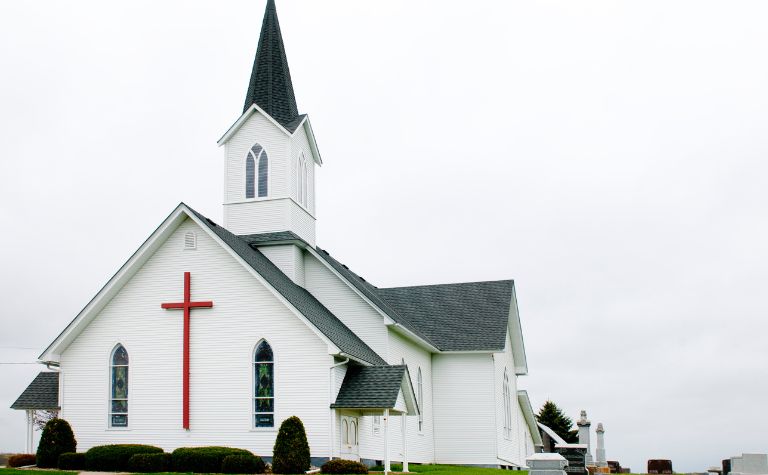The terms “Protestant” and “Reformed” are both used to describe Christians, each with certain sets of beliefs and practices. However, Protestant and Reformed Christians, as well as their churches, have many overlapping convictions.
The term “Protestant” describes the 500-year-old movement that started when its founders attempted to reform certain teachings and practices in the Roman Catholic Church. “Reformed” describes one type of Protestant Christian that subscribes to the theological principles of French Reformer John Calvin.
What is the difference between Reformed Protestants and non-Reformed Protestants? How do their origins, influential writings, and largest denominations compare? What are some examples of Reformed churches and denominations? Keep reading to learn the answers to these questions and others.
Also, see Protestant vs. Catholic vs. Orthodox Compared to learn more.

Protestant Christian Compared to Reformed Protestant Christian
The term “Protestant” describes a wide swath of Christians, including Baptists, Presbyterians, Methodists, Lutherans, and Pentecostals. Protestants may be Reformed (or Calvinist), Arminian, or something else. (Also see Protestant vs. Pentecostal: What’s the Difference?)
The term “reformed” has various uses in the context of Christian history and theology, so it is important to understand the context of a discussion to determine its meaning.
- Use #1 | “Reformed” means not Catholic: Some people use the term “Reformed” to refer to Christian traditions in the West that are distinct from Catholicism. The “Protestant Reformation” refers to the 16th-century movement in Europe that protested abuses in the Catholic church. In this use, “Reformed” describes any tradition or denomination born out of the Reformation, like Lutheran, Presbyterian, and Anabaptist.
- Use #2 | “Reformed” means not Lutheran or Anabaptist: The term “Reformed” in some Protestant contexts refers to traditions born out of the Reformation that are neither Lutheran nor Anabaptist. While this use of the word mostly refers to the teachings of French Reformer John Calvin (1509-1564), it can refer to the teachings of Swiss Reformer Ulrich Zwingli (1484-1531), which are similar (e.g., predestination) but have differences (e.g., ecclesiology).
- Use #3 | “Reformed” means Calvinism: Many people use the term “Reformed” as a synonym for Calvinism. Others use it as a synonym for Presbyterian because of its Calvinist theology. There are contexts in which distinctions should be made. For example, a “Reformed Baptist” church is not Presbyterian but combines Calvinist theology with a congregational, rather than elder-led (i.e., presbyterian), form of church government.
- Use #4 | “Reformed” means confessional commitment: Some define “Reformed” in a narrower sense than the above uses. In such cases, the term refers to a church or individual who subscribes to the Heidelberg Confession of Faith (1563), the Belgic Confession of Faith (1561), and the Canons of Dort (1619). (Also see Do Protestants Have Confession?)
All the uses of “Reformed” mentioned above are within the scope of “Protestant” Christianity.
| Protestant | Reformed | |
|---|---|---|
| Origin | Protestantism was born in 16th-century Europe, centered in Germany, under the reforms of Martin Luther (1483-1546). | The Protestant Reformation, especially in France under Calvin and Switzerland under Zwingli. |
| Meaning of the name | The word “Protestant” comes from the Latin word protestari, meaning “to bear witness.” | “Reformed” refers to reforms made in reaction to alleged errs in doctrine and practice in the Catholic church. |
| Approximate membership | 1 billion worldwide | Since “Reformed,” in the theological use of the term, is not a denomination per se, it is difficult to estimate the total number of adherents. |
| Early influencer | Martin Luther, John Calvin of France (1509-1564), and Ulrich Zwingli of Switzerland (1484-1531) | Calvin, Zwingli, John Knox (1514-1572) |
| Significant writing outside the Bible | The Apostles Creed, the Nicene Creed; the writings and sermons of Martin Luther, especially the 95 Theses, Calvin’s The Institutes of the Christians Religion; many others | Calvin’s The Institutes of the Christian Religion; the Westminster Confession of Faith (1646); the Heidelberg Confession of Faith, the Belgic Confession of Faith, and the Canons of Dort |
| What are the largest denominations in the tradition today? | Southern Baptist Convention, the United Methodist Church, the Evangelical Lutheran Church of America, and the Assemblies of God | The largest Reformed tradition is Presbyterianism. |
Also, see Protestant vs. Methodist: What’s the Difference?

Protestant vs. Reformed Beliefs: Similarities and Differences
| Protestantism | Reformed | |
|---|---|---|
| Scripture | One of the hallmarks of the Protestant tradition is the authority of Scripture over and above church tradition. Protestants historically believe in the inspiration and authority of Scripture. “Sola Scriptura” refers to the Protestant belief that Scripture is sufficient and authoritative to know how to be saved and live a life that pleases God. | Reformed churches are in general agreement with other Protestant traditions regarding the inspiration and authority of Scripture. |
| God | Protestants believe in the Trinity, one God who exists in three persons: the Father, Son, and Holy Spirit, are each fully divine. | Reformed Christians are devout Trinitarians like other Protestant believers. |
| Christ | Jesus is the second person of the Trinity. He is God in human flesh. He is 100% God and 100% man. Jesus was born of a virgin, lived a sinless life, died as a substitutionary atonement for sin, and was physically resurrection on the third day. | Reformed Christians fully subscribe to the incarnation, virgin birth, and sinless life of Christ. Reformed theology believes in the penal- substitutionary atonement of Christ and his physical resurrection from the dead. |
| Salvation | Protestants believe that salvation is by grace through faith in Christ alone. Protestants can be Arminian, Calvinist, Baptist, or something else. | Reformed theology teaches that God implants faith into the heart of a person so that he or she can respond to the gospel of Jesus Christ. God unconditionally elects people for salvation and dispenses his grace to sinners, which they cannot resist. |
| Covenants | Some Protestant theologies are covenantal. | Reformed theology stresses the centrality of God’s covenant of redemption, of works, and of grace. |
Also, see the Catholic’s Lord’s Prayer vs Protestant’s Lord’s Prayer.

What Are Examples of Reformed Churches and Denominations?
The name “Reformed” in broad use does not describe a Protestant denomination akin to terms like Presbyterian, Baptist, Methodist, or Assemblies of God. There are, however, networks of churches that use the term “Reformed” in their name, including:
- Associate Reformed Presbyterian Church
- Christian Reformed Church in North America
- Evangelical Association of Reformed and Congregational Churches
- Netherlands Reformed Congregations in North America
- Protestant Reformed Churches in America
- Reformed Church in America
- Reformed Church in the United States
- Reformed Presbyterian Church of North America
- United Reformed Churches in North America
Why isn’t there just one Reformed church? While the churches listed above have more similarities than differences, they do not agree on all matters of belief and practice. (Also see 7 Symbols of Protestant Christianity)
Additionally, the churches listed above are not necessarily due to differences in peripheral matters that have turned into church splits. Sometimes the differences come from the region or culture of a church’s origin.
Church historian W.S. Reid explains, “Calvin’s teachings have been followed by many different individuals and groups who came out of the Reformation down to the present day, but they have not always followed exactly the same line of thinking or development.”
He continues, “Thus, in the Reformed tradition, Calvinists, while basically agreeing and resembling each other in many ways, have certain differences produced by historical and even geographical circumstances. These differences have resulted in a number of what might be called lines or strains in the tradition.” [1]
Please see the related articles below.
References:
[1] Source
[2] Source
[3] Source
Related Questions
Catholic vs. Protestant vs. Orthodox: What's the Difference?
Roman Catholicism, Protestant Christianity, and the Eastern Orthodox Church are the three historical branches of the Christian religion. Each tradition traces its doctrines and practices to the New...
Protestantism and Anglicanism are branches of the Christian faith that have roots in Europe. Protestantism and Anglicanism have similarities and differences with each other as well as other...
